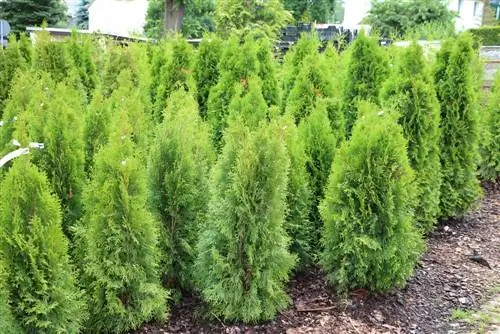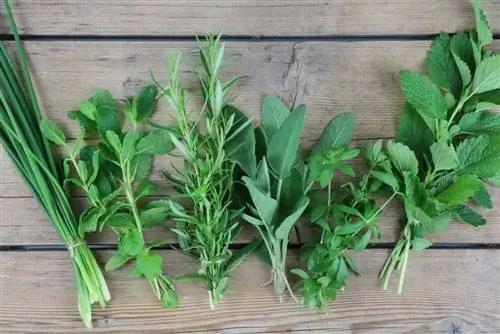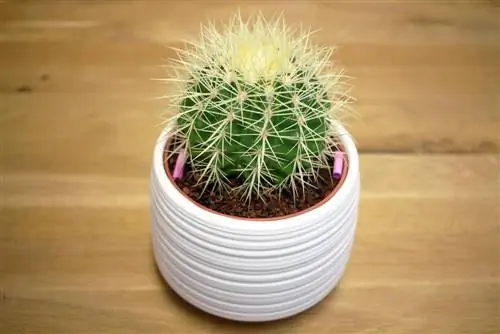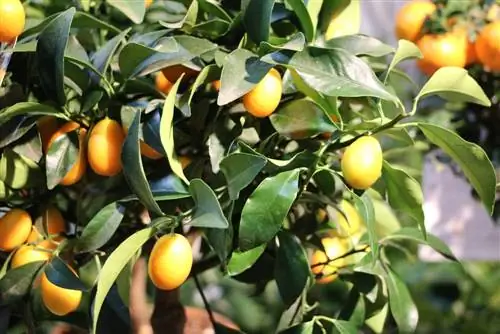- Author admin [email protected].
- Public 2023-12-17 03:39.
- Last modified 2025-01-24 12:45.
Nitrogen ensures he althy growth and the green color of the grass. As a result, they must be supplied with lawn fertilizer at certain intervals. You can make effective nitrogen fertilizers yourself relatively easily.
Homemade nitrogen fertilizer
A balanced nitrogen balance is essential for the lawn. The right fertilizer ensures an optimal supply of nitrogen. It doesn't even have to be expensive, because many of the ingredients are found in the home, garden or stable. They can be used to produce nitrogen fertilizer or nitrogen-containing fertilizer in solid and liquid form.
In solid form
There are many simple ways to make an effective nitrogen fertilizer yourself:
From coffee grounds
Coffee grounds are a waste product that occurs in almost every household. In addition to potassium and phosphorus, it also contains a lot of nitrogen, which makes it an excellent natural fertilizer. It decomposes very slowly, so over-fertilization can be ruled out. However, this requires a larger amount, so you have to collect it first. But how do coffee grounds become fertilizer?
- Collect coffee grounds over several days
- then dry well to avoid mold formation
- spread well on an absorbent surface
- best in the sun
- Store leftover coffee grounds in a dry, airy place
- mow the lawn before fertilizing
- distribute the dried grounds evenly over the lawn
- Work shallowly into the soil with a rake
Tip:
If you add coffee grounds to the compost, it attracts earthworms and can accelerate rotting.
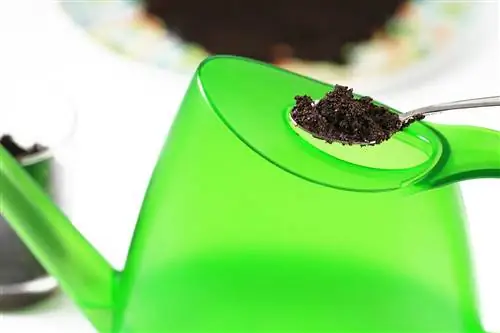
Kitchen and garden waste
A good nitrogen-containing fertilizer can also be made from kitchen and garden waste. We're talking about compost, the classic fertilizer. The main work here is carried out by soil organisms that convert the waste into valuable humus. Compost can be created using a quick composter, a wooden crate or simply as a compost heap. It can be layered up gradually over the year or completely immediately. Composting is quickest with the latter.
- look for a partially shaded spot in the garden
- with open floor, not concrete
- Compost must be well ventilated all around
- Rabbit wire on the floor to protect against rodents
- then fill in the material in layers
- bottom layer made from tree or hedge cuttings
- on it leaves, grass clippings, smaller twigs
- as next layer, garden scraps and kitchen waste
- Sprinkle in chopped twigs every now and then
- as the top layer of grass clippings
So that the compost does not dry out, it must be watered occasionally, but covered during heavy rain. It is ripe after around eight to twelve months. Kitchen waste such as eggshells, coffee grounds, tea bags and fruit scraps, garden waste in the form of leaves, lawn clippings, wood ash (max.3%) and woody shredded material as well as manure and algae from the garden pond. If you use a commercially available quick composter, the materials filled in must be chopped or cut into small pieces.
Tip:
A good alternative to normal compost is vermicompost, whose nitrogen content is higher than that of normal compost. The latter must be implemented regularly every three months to promote ventilation.
Excreta from farm animals
Manure from various farm animals is one of the most traditional nitrogen fertilizers. The highest concentration is found in manure from sheep, cattle and pigs. It is just below that for poultry, dairy cattle and horse manure. In order to be able to use the excretions as fertilizer, they must be processed or prepared accordingly.
- never apply fresh manure
- Ammonia contained would burn grass
- compost before spreading
- mix with other organic materials for composting
- such as grass clippings, straw, leaves and other garden waste
- cover with tarpaulin to protect against moisture
- Duration of rotting varies
- Horse manure rots faster than cow manure
- requires at least one year
- Manure decomposes during this time
- Disease germs die off
- preferably applied before creating a new lawn
- otherwise spread on the lawn in spring
- work in easily with a rake or rake
Unfortunately, these natural nitrogen fertilizers also have one or two disadvantages. They can increase the salinity of the soil and promote weed growth. In addition, you should only compost as much manure as possible. Store as you can use next year.
Tip:
The duration of rotting depends on the species, gender, age of the animal and the food.
Lawn cutting
The easiest way to supply the lawn with nitrogen is to mulch with grass clippings. However, some of the nitrogen is lost by soil organisms, so mulch is usually not sufficient as the sole nitrogen fertilizer.
- ideally use a mulching mower
- have special knives
- Lawn should definitely be dry
- mow the lawn normally
- Knives cut and shred the grass at the same time
- Lawn clippings trickle to the ground
- Material gradually decomposes
- is then available as fertilizer
- mow about once a week
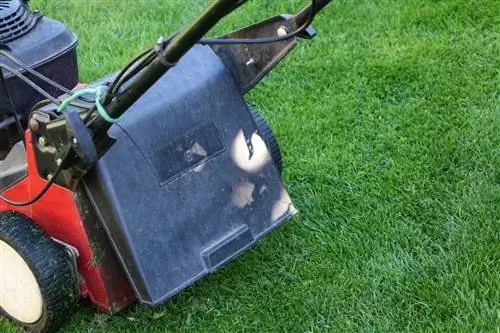
The clippings should neither be too wet nor too long or distributed unevenly over the surface. In places where it is applied too thickly, the grasses cannot be supplied with sufficient light and oxygen. This affects the formation of leaf green, the grass turns yellow and begins to rot.
Make liquid fertilizer
As an alternative to solid nitrogen-containing fertilizers, liquid fertilizers can also be produced with little effort. In the form of manure, which you then spread with a watering can. Unfortunately, these types of fertilizers have a very strong smell, but are all the more effective. The smell can be alleviated somewhat if you sprinkle some stone dust over the brew during fermentation.
Manure from nettles
A lawn fertilizer made from nettles contains lots of nitrogen and is easy to make. In addition to nettles, you need gloves to protect against the stinging hairs, a plastic bucket or a wooden barrel with a cover, scissors and rainwater.
- cut one kilogram of fresh nettles into small pieces
- the smaller, the better
- alternatively 150 g dried herb
- Put clippings in the bucket
- then pour 10 liters of rainwater over it
- mix everything well and cover the container
- then stir once a day
- Fermentation process starts after one or two days
- shown by rising bubbles, foam formation
- Fermentation complete when no more bubbles form
- after about 10-14 days
- sieve out fermented plant residues
- Dispose of plant residues in the compost
- or use as mulch
- Dilute manure 1:20 with water and spread on the lawn
Tip:
Metal containers should not be used to prepare manure, as chemical processes take place between manure and metal.
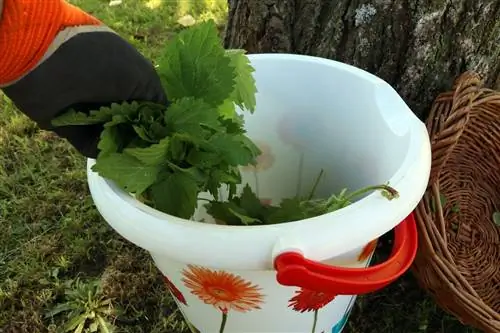
Manure from stable manure
If you use farmyard manure, you get an effective nitrogen fertilizer. A corresponding manure can be made from different types of manure. However, the manure should already be well rotted.
- mix the rotted manure with wood ash
- three parts manure and two parts wood ash
- only use wood ash from untreated wood
- Pour the mixture into a close-meshed net
- alternatively use an old potato sack
- Put the net or bag in water
- don’t use too much water
- the more water, the less you have to dilute later
- put the whole thing in a warm and shady place
- finished manure after a few weeks
- Manure should then be clear and dark brown
A nitrogen-containing lawn fertilizer such as commercially available NPK fertilizers is used. Under no circumstances should it be used pure, but always diluted accordingly. It is best to dilute it with water until the color resembles that of black tea. It can be applied from March to July.


